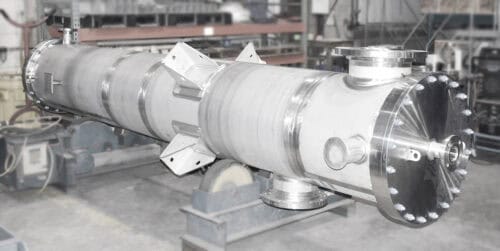Introduction to Evaporation Technology
Evaporation is a critical process across multiple industries, enabling concentration, purification, and recovery of valuable materials. Whether in food processing, pharmaceuticals, chemical manufacturing, or wastewater treatment, evaporation equipment—like shell and tube heat exchangers—play a crucial role in enhancing efficiency, sustainability, and cost reduction.
While many associate evaporators with solvent recovery after plant oil extraction, their applications extend far beyond that. Here, we’ll explore the diverse uses of evaporation technology and how engineers can optimize these systems for maximum performance.

Enerquip falling film evaporators for a plant oil extraction process
How an Evaporator Works
An evaporator functions by applying heat to a liquid, causing its volatile components to vaporize while leaving behind concentrated solids or solutes. Depending on the industry, either the vaporized material or the concentrated residue can be the desired product.
Evaporators are essential for:
✔ Concentrating valuable substances in food, pharmaceuticals, and chemicals
✔ Purifying solvents and liquids for reuse, reducing waste
✔ Enhancing sustainability in water treatment and environmental applications
The Many Applications of Evaporators
1. Food & Beverage Processing
Evaporation plays a key role in the concentration and preservation of food and beverages, enhancing flavor, texture, and shelf life.
- Fruit Juice Concentration – Removing excess water while preserving nutrients and taste.
- Dairy Processing – Concentrating milk, whey, and other dairy products for further processing into powders or condensed milk.
- Sugar Production – Thickening sugar syrups before crystallization.
2. Pharmaceutical & Biotechnology Industries
Precision is crucial in pharmaceutical manufacturing, and evaporators support multiple processes, including:
- Active Ingredient Concentration – Ensuring that medicinal compounds reach the desired potency.
- Essential Oil Extraction – Producing pure, high-quality oils for use in aromatherapy, skincare, and medicine.
- Solvent Recovery – Purifying solvents used in drug formulation for reuse, reducing waste and costs.
3. Chemical & Petrochemical Manufacturing

Vertical straight tube exchanger for an industrial multi-stage evaporation process
Industrial evaporators are vital for chemical production, supporting processes such as:
- Concentrating Acids and Alkalis – Used in manufacturing detergents, fertilizers, and industrial chemicals.
- Solvent Separation – Recovering and purifying solvents from reaction mixtures.
- Polymer and Resin Production – Controlling viscosity and composition through precise evaporation techniques.
4. Wastewater Treatment & Environmental Applications
With sustainability becoming a top priority, evaporation systems are helping industries manage waste more effectively:
- Industrial Waste Reduction – Removing water from liquid waste streams to minimize disposal costs.
- Brine Concentration in Desalination – Extracting fresh water while reducing brine volume.
- Heavy Metal Recovery – Allowing industries to reclaim valuable metals from wastewater for reuse.
5. Textile & Dye Manufacturing
Evaporation processes are used to:
- Enhance Dye Fixation – Removing excess water from dye solutions to ensure deeper color penetration and durability.
- Textile Finishing – Assisting in chemical concentration for fabric treatment processes.
6. Power Generation & Renewable Energy
Thermal evaporation is an essential component of:
- Steam Power Plants – Concentrating boiler feedwater to optimize energy efficiency.
- Biofuel Production – Removing water from bioethanol and biodiesel mixtures to improve fuel quality.
- Thermal Desalination for Power Plants – Recycling water for use in cooling systems and steam generation.
Choosing the Right Evaporation Equipment
With such a wide range of applications, shell and tube heat exchanger design for evaporation is critical. Engineers and facility managers must consider factors such as:
- Flow Rate & Scalability – Systems must be designed to handle varying input volumes efficiently.
- Energy Consumption – Minimizing heat loss and optimizing energy use for cost savings.
- Material Compatibility – Ensuring the system can withstand corrosive substances or food-grade applications.
- Sanitary Design – Polished surfaces and easy-cleaning features for industries with strict hygiene requirements.
The Future of Evaporation Technology
As industries push for greater efficiency, sustainability, and cost-effectiveness, evaporation technology will continue to evolve. Advances in automation, heat recovery, and modular system design are making these systems more adaptable than ever.
If you’re considering implementing an evaporation system or upgrading your current setup, Enerquip’s experts can help you find the best solution for your needs. Contact us today to explore customized solutions for your industry.
More from the Enerquip Blog
Rouging: What It Is and How to Avoid It
The Case for Waste Heat Recovery: Why Your Facility Shouldn’t Ignore It
Why Careful Wastewater Treatment for Breweries Matters
Closed-Loop Process Cooling Reduces Water, Energy Use in Pharmaceutical Manufacturing
Common Questions About Pharma-Grade Shell and Tube Heat Exchangers
Decoding the Delicate Balance of Sizing Shell and Tube Heat Exchangers
